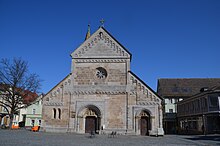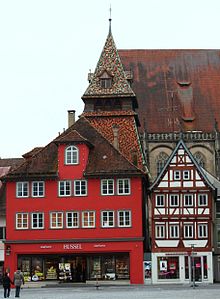Johannisplatz (Schwäbisch Gmünd)


The Johannisplatz is next to the market square and the cathedral square one of the three main squares in the old town of Schwabisch Gmund . The square extends north and west of the Romanesque Johanniskirche . To the west of the limited space is through the former preacher monastery , where the today Museum preacher and the gallery on the preachers are housed. The Bockgasse passes through the space south. In the east the square turns into the market square.
History and use
Like Münsterplatz, Johannisplatz has long housed a cemetery north of the Johanniskirche. The cemetery was laid out around the St. Veit cemetery chapel, which was demolished in 1803 . Its outlines were determined by excavations by Hans-Wolfgang Bächle in 1972 and traced in the pavement. Today they are overbuilt by a water playground. Depending on the theory, the Carolingian cell from the Fulrad period associated with the founding legend could have been located on Johannisplatz near St. Veit .
In 1804 the square was leveled and in 1831 paved in order to use it as a parade ground for the barracks in the former preacher's monastery. The square has been a pedestrian zone since 1972 . The square hosts the weekly municipal farmers' market , as well as various market events every year, for example parts of the Christmas market or the grocer's market at church fair . The square is also used by the European Church Music Festival .
building
In addition to the main buildings already mentioned, there are other houses classified as cultural monuments around the square. The house Johannisplatz 6 is a half-timbered gable house from around 1560, which was extensively rebuilt in 1989. The house at Bocksgasse 13 is equipped with an exposed framework. The half-timbered structures date from the second half of the 16th century. It was rebuilt in 1970 according to a design by Walter Supper and provided with a rear extension.
Former Kramerzunfthaus, Café Margrit (Johannisplatz 10)
The house has appeared as a stately hipped roof house since the renovations around 1820 and 1900 . After analyzing the beams and the cellar, the origins of the house are in the early 14th century. Following the layout of the basement and the house drawings in Dominikus Debler's chronicle , the Kramer guild house was originally divided into two parts. Debler describes the house as dilapidated in 1815. Sailer Herlikofer, who acquired the house in 1815, had it standardized. In 1900 the door was moved to the east side and the south side was equipped with large shop windows. Initially used as a shop, the house was converted into a terrace café in 1956.
Mayor Storr House (Bocksgasse 11)
A patrician house from the end of the 16th century with older parts from the 14th century. Large round-arched shop windows from 1700 were preserved until 1953. The spacious staircase has a classical staircase with rich decorations. The first and second floors are stuccoed . On the second floor there is a rich stucco relief ceiling from 1725, which is attributed to Dominikus Zimmermann , who also worked at the neighboring Predigerkirche . Renovations and repairs were carried out in 1655, 1725, 1800, 1862, 1922 and profoundly in 1953 and again in 2012.
Monuments
The sculpture Mourning (Mourning) by the Israeli artist Menashe Kadishman has stood in front of the west facade of St. John's Church since 1996 . The grieving woman was cut out of a steel plate with a laser beam and is bent over the coffin of her child. The sculpture is a reminder that Johannisplatz was one of the city's cemeteries until 1803.
In 2012, a Staufer stele was installed at the choir of the former preacher's church , which is intended to commemorate Schwäbisch Gmünd as the oldest town founded by the Staufers and the work of the Staufer in Schwäbisch Gmünd.
gallery
Menashe Kadishman : Mourning (grief) , Stahl, 1996
Markus Wolf : Staufer column , Jura travertine, 2012
literature
- Richard Strobel: The art monuments of the city of Schwäbisch Gmünd. Volume 3: Secular buildings of the old town without fortifications , Deutscher Kunstverlag, Munich 1995, ISBN 3-422-00570-6 , pp. 36–42 and 115–118.
Web links
Individual evidence
- ↑ Mourners on schwaebisch-gmuend.de. Retrieved May 18, 2014.
- ↑ Schwäbisch Gmünd 2012 on stauferstelen.net. Retrieved May 17, 2014.
Coordinates: 48 ° 47 '59.4 " N , 9 ° 47' 47" E



